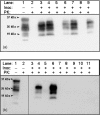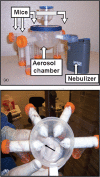Aerosol and nasal transmission of chronic wasting disease in cervidized mice
- PMID: 20164261
- PMCID: PMC2888164
- DOI: 10.1099/vir.0.017335-0
Aerosol and nasal transmission of chronic wasting disease in cervidized mice
Abstract
Little is known regarding the potential risk posed by aerosolized prions. Chronic wasting disease (CWD) is transmitted horizontally, almost surely by mucosal exposure, and CWD prions are present in saliva and urine of infected animals. However, whether CWD may be transmissible by the aerosol or nasal route is not known. To address this question, FVB mice transgenetically expressing the normal cervid PrP(C) protein [Tg(cerPrP) mice] were exposed to CWD prions by either nose-only aerosol exposure or by drop-wise instillation into the nostrils. Mice were monitored for signs of disease for up to 755 days post-inoculation (p.i.) and by examination of tissues for lesions and PrP(CWD) after necropsy. In particular, nasal mucosa, vomeronasal organ, lungs, lymphoid tissue and the brain were assessed for PrP(CWD) by Western blotting and immunohistochemistry. Six of seven aerosol-exposed Tg(cerPrP) mice developed clinical signs of neurological dysfunction mandating euthanasia between 411 and 749 days p.i. In all these mice, CWD infection was confirmed by detection of spongiform lesions and PrP(CWD) in the brain. Two of nine intranasally inoculated Tg(cerPrP) mice also developed transmissible spongiform encephalopathy associated with PrP(CWD) between 417 and 755 days p.i. No evidence of PrP(CWD) was detected in CWD-inoculated Tg(cerPrP) mice examined at pre-terminal time points. These results demonstrate that CWD can be transmitted by aerosol (as well as nasal) exposure and suggest that exposure via the respiratory system merits consideration for prion disease transmission and biosafety.
Figures




References
-
- Beekes, M. & McBride, P. A. (2000). Early accumulation of pathological PrP in the enteric nervous system and gut-associated lymphoid tissue of hamsters orally infected with scrapie. Neurosci Lett 278, 181–184. - PubMed
-
- Browning, S. R., Mason, G. L., Seward, T., Green, M., Eliason, G. A., Mathiason, C., Miller, M. W., Williams, E. S., Hoover, E. & Telling, G. C. (2004). Transmission of prions from mule deer and elk with chronic wasting disease to transgenic mice expressing cervid PrP. J Virol 78, 13345–13350. - PMC - PubMed
-
- Buck, L. & Axel, R. (1991). A novel multigene family may encode odorant receptors: a molecular basis for odor recognition. Cell 65, 175–187. - PubMed
Publication types
MeSH terms
Substances
Grants and funding
LinkOut - more resources
Full Text Sources
Research Materials
Miscellaneous

